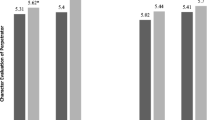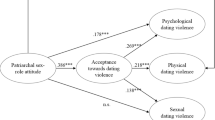Abstract
This study clarifies and adds to our understanding of how gender and gender orientation affect physical aggression in dating relationships. The stereotype of male violence assumes that men exclusively or nearly exclusively use abusive and violent behavior to manage conflict situations with an intimate partner, and that the more violent men will be more masculine. Data from a sample of 336 undergraduates indicate that the expected sex differences were not observed; among college students, physical aggression in dating relationships is not gender-specific. However, gender orientation was significantly related to courtship aggression. A more masculine and/or less feminine gender orientation and variations in relationship seriousness proved to be the two strongest predictors of both men's and women's involvement in courtship violence. Findings are discussed in terms of the masculine mystique and the male role norms in our culture's superstructure.
Similar content being viewed by others
References
Arias, I., Samios, M., & O'Leary, K. D. (1987). Prevalence and correlates of physical aggression during courtship. Journal of Interpersonal Violence, 2, 82–90.
Bem, S. (1981). The Bem Sex Role Inventory Professional Manual. Palo Alto, CA: Consulting Psychologist Press.
Bem, S. L. (1983). Gender schema theory and its implications for child development: Raising gender-aschematic children in a gender-schematic society. Signs, 8, 588–616.
Bernard, M. L., & Bernard, J. L. (1984). The abusive male seeking treatment: Jekyll and Hyde. Family Relations, 33, 543–547.
Bernard, J. L., Bernard, S., & Bernard, M. L. (1985). Courtship violence and sex-typing. Family Relations, 34, 573–576.
Billingham, R. E., & Sack, A. R. (1986). Courtship violence and the interactive status of the relationship. Journal of Adolescent Research, 1, 315–325.
Brannon, R. (1976). The male sex role: Our culture's blueprint for manhood, and what it's done for us lately. Deborah David & Robert Brannon (Eds.), The forty-nine percent majority: The male sex role. Reading, MA: Addison-Wesley.
Burke, P. J., Stets, J. E., & Pirog-Good, M. A. (1988). Gender identity, self-esteem, and physical and sexual abuse in dating relationships. Social Psychology Quarterly, 51, 272–285.
Cancian, F. M. (1985). Gender politics: Love and power in the private and public spheres. In Alice S. Rossi (Ed.), Gender and the life course. New York: Aldine.
Deal, J. E., & Wampler, K. S. (1986). Dating violence: the primacy of previous experience. Journal of Social and Personal Relationships, 3, 457–471.
Dobash, R., & Dobash, R. (1979). Violence against wives. New York: Free Press.
Eagly, A. H., and Steffen, V. J. (1986). Gender and aggressive behavior: A meta-analytic review of the social psychological literature. Psychological Bulletin, 100, 309–330.
Gelles, R. J., & Cornell, C. P. (1985). Intimate violence in families. Newbury Park, CA: Sage.
Goldstein, D., & Rosenbaum, A. (1985). An evaluation of the self-esteem of maritally violent men. Family Relations, 34, 425–428.
Gwartney-Gibbs, P. A., Stockard, J., & Bohmer, S. (1987). Learning courtship aggression: The influence of parents, peers, and personal experiences. Family Relations, 36, 276–282.
Henton, J. M., Cate, R. M., Koval, J., Lloyd, S., & Christopher, F. S. (1982). Romance and violence in dating relationships. Journal of Family Issues, 4, 467–482.
Lipman-Blumen, J. (1984). Gender roles and power. Englewood Cliffs, NJ: Prentice Hall.
Lloyd, S. A. (1987). Conflict in premarital relationships: Differential perceptions of males and females. Family Relations, 36, 290–294.
Makepeace, J. (1983). Life events, stress, and courtship violence. Family Relations, 32, 101–109.
Makepeace, J. (1986). Gender differences in courtship violence victimization. Family Relations, 35, 383–388.
Malone, J., Tyree, A., & O'Leary, K. D. (1989). Generalization and containment: Different effects of past aggression for wives and husbands. Journal of Marriage and the Family, 51, 687–697.
Marshall, L. L., & Rose, P. (1987). Gender, stress and violence in the adult relationships of a sample of college students. Journal of Social and Personal Relationships, 4, 299–316.
Mason, A., & Blankenship, V. (1987). Power and affiliation motivation, stress, and abuse in intimate relationships. Journal of Personality and Social Psychology, 52, 203–210.
Matthews, W. J. (1984). Violence in college couples. College Student Journal, 18, 150–158.
O'Keefe, N., Brockopp, K., & Chew, E. (1986). Teen dating violence. Social Work, 31, 465–468.
O'Leary, K. D., Barling, J., Arias, I., Rosenbaum, A., Malone, J., & Tyree, A. (1989). Prevalence and stability of physical aggression between spouses: A longitudinal analysis. Journal of Consulting and Clinical Psychology, 57, 263–268.
Pedhazur, E. J., & Tetenbaum, T. J. (1979). Bem Sex Role Inventory: A theoretical and methodological critique. Journal of Personality and Social Psychology, 37, 996–1016.
Pleck, J. H. (1981). The myth of masculinity. Cambridge, MA: MIT Press.
Pleck, E. H., Pleck, J. H., Grossman, M., & Bart, P. B. (1977–78). The battered data syndrome: A comment on Steinmetz' article. Victimology: An International Journal, 2, 680–682.
Risman, B., & Schwartz, P. (1989). Gender in intimate relationships: A microstructural approach. Belmont, CA: Wadsworth.
Sigelman, C. K., Berry, C. J., & Wiles, K. A. (1984). Violence in college students' dating relationships. Journal of Applied Social Psychology, 5, 530–548.
Simmel, G. (1955). Conflict and the web of group affiliation. New York: Free Press.
Spence, J., & Helmreich, R. L. (1978). Masculinity and femininity: Their psychological dimensions, correlates and antecedents. Austin: University of Texas Press.
Spence, J., Deaux, K., & Helmreich, R. L. (1984). Sex roles in contemporary American society. In Lindzey, G., & Aronson, E. (Eds.), Handbook of sociology psychology (3rd ed.). Reading, MA: Addison-Wesley.
Sprey, J. (1979). Conflict theory and the study of marriage and the family. In Burr, W. R. et al. (Eds.), Contemporary theories about the family (Vol. 2). New York: Free Press.
Stets, J. E., & Pirog-Good, M. A. (1987). Violence in dating relationships. Social Psychology Quarterly, 50, 237–246.
Straus, M. A. (1979). Measuring intrafamily conflict and violence: The Conflict Tactics (CT) Scale. Journal of Marriage and the Family, 41, 75–88.
Straus, M. A. (1989). The conflict tactics scale and its critics: An evaluation and new data on validity and reliability. In Straus, M., & Gelles, R. J. (Eds.), Physical violence in American families: Risk factors and adaptation to violence in 8,145 families. New York: Transaction Press.
Sugarman, D. B., & Hotaling, G. T. (1989). Dating violence: Prevalence, context, and risk markers. In Pirog-Good, M., & Stets, J. E. (eds.), Violence in dating relationships: Emerging social issues. New York: Praeger.
Szinovacz, M. E. (1983). Using couple data as a methodological tool: The case of marital violence. Journal of Marriage and the Family, 45, 633–644.
Taubman, S. (1986). Beyond the bravado: Sex roles and the exploitative male. Social Work, 31, 12–18.
Toby, J. (1966). Violence and the masculine ideal: Some qualitative data. Annals of the American Academy of Political and Social Science, 36, 19–27.
Yllo, K. (1988). Political and methodological debates in wife abuse research. In Yllo, K., & Bograd, M. (Eds.), Feminist perspectives on wive abuse. Newbury Park, CA: Sage.
Author information
Authors and Affiliations
Additional information
This project was funded in part by a faculty research grant from Holy Cross College.
Rights and permissions
About this article
Cite this article
Thompson, E.H. The maleness of violence in dating relationships: an appraisal of stereotypes. Sex Roles 24, 261–278 (1991). https://doi.org/10.1007/BF00288301
Issue Date:
DOI: https://doi.org/10.1007/BF00288301




